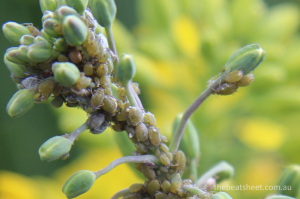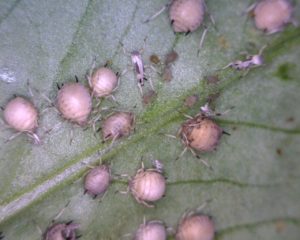
Turnip aphid on canola
A wide range of aphid species can affect field crops. Most are small (only a couple of millimetres long) with oval-shaped green, brown or black bodies. Often occurring in colonies, aphids suck on plant sap, causing loss of vigour, and in some cases yellowing, stunting or distortion of plant parts. Secreted honeydew (unused sap) can promote the development of sooty mould. In crops such as cotton, the honeydew affects fibre quality.
Their feeding rarely causes major damage in most crops, and control measures are usually not warranted, as a range of parasites and predators keep population numbers down. Exceptions may be where:
- the crop is under moisture stress
- heavy populations are observed
- virus outbreaks are likely to be a problem.
Sampling and threshold information for aphids in cotton is available in the Cotton Pest Management Guide.
Aphid pests of field crops
Aphid species found in cereal crops include:
- Diuraphis noxia—Russian wheat aphid
- Metopolophium dirhodum—rose-grain aphid
- Rhopalosiphum maidis—corn aphid
- Rhopalosiphum padi—oat aphid, wheat aphid
- Rhopalosiphum rufiabdominalis—rice root aphid.
Aphid species found in broadleaf field crops include:
- Acyrthosiphon kondoi—bluegreen aphid
- Acyrthosiphon pisum—pea aphid
- Aphis craccivora—cowpea aphid
- Aphis glycine—soybean aphid
- Aphis gossypii—cotton aphid
- Brevicoryne brassicae—cabbage aphid
- Lipaphis erysimi—turnip aphid
- Megoura crassicauda—faba bean aphid
- Myzus persicae—green peach aphid
- Therioaphis trifolii—spotted alfalfa aphid.
Images of many of the above species are available in our aphid image gallery and in a printable Aphid ID guide (download the pdf from the Beatsheet Resources page).
Aphids as virus vectors
When aphids transmit viruses, the impact on crop growth and yield can be significant. The earlier the transmission of virus, the greater the potential impact.
|
Aphid species |
Plant hosts |
Vector for |
|---|---|---|
| Blue green aphid | Canola, pulses, lucerne & other pasture legumes |
|
| Cabbage aphid | Canola and other brassica crops and weeds | |
| Corn aphid | Sorghum, winter cereals, pasture grasses |
|
| Cotton aphid | Cotton and weeds |
|
| Cowpea aphid | Pulses, pasture legumes, potatoes |
|
| Faba bean aphid | Faba bean and vetches, lucerne |
|
| Green peach aphid | Canola, wild radish and wild turnip, lupins, capeweed plus others |
|
| Oat aphid | Winter cereals, pasture grasses |
|
| Pea aphid
|
Faba beans, field peas, lucerne |
|
| Rose grain aphid | Winter cereals, grasses |
|
| Russian wheat aphid | Barley and wheat highly susceptible. Oats tolerant. Other winter cereal crops intermediate
Not known to build up in sorghum. |
Can transmit BYDV, but is not as effective a vector as the other cereal infesting aphid species. |
| Soybean aphid | Soybeans | Not known to transmit virus within Australia. In China it transmits soybean mosaic virus. |
| Turnip aphid | Canola and other brassica crops and weeds |
Aphid parasitism

Parasitised aphids (mummies) by the wasp Aphidius colemani
Aphid parasitoids are small wasps that lay their eggs inside the body of aphids. The larva develops, slowly eating the aphid and killing it before the wasp completes development and emerges from the dead aphid. In the process of developing, the wasp larva spins a cocoon inside the aphid. These swollen, brown ‘mummies’ are evidence of parasitoid activity in an aphid colony. The emerging wasp cuts an exit hole in the remains of its host.
Parasitoids detect aphids from odours produced by both the aphid and the infested plant. Parasitoids are able to detect small numbers of aphids, and therefore have the potential to suppress these small populations, preventing them establishing and increasing to outbreak proportions.
Common and widespread species of aphid parasitoids and their hosts include:
- Lysiphlebus testaceipes: corn aphid, oat aphid and cowpea aphid
- Aphidius colemani: green peach aphid, turnip aphid, corn aphid and oat aphid
- Aphidius ervi: rose grain aphid, blue green aphid and pea aphid
- Diaeretiella rapae: cabbage aphid
Parasitoids don’t have it all their own way. Aphids can fight back—wasps may be injured by large aphids, or entangled in the cornical wax that the aphids secrete in response to parasitoid activity in the colony.
Surveillance for resistance in cotton aphids
A CRDC-supported surveillance program of cotton aphids by NSW DPI has found populations from far north Queensland and southern Queensland in the in 2023/24 season were susceptible to sulfoxaflor and thiamethoxam with very low resistance to clothianidin and acetamiprid. Unlike two spotted spider mite, there was no resistance detected to diafenthiuron in cotton aphids in 2023/24.
Following widespread re-emergence of Group 1 resistance in cotton aphids during the 2022/23 season, moderate to high levels of resistance to pirimicarb and dimethoate was detected in 100% of aphid populations from far north Queensland and southern Queensland.
Further information
The GPA insecticide resistance management strategy is available from IPM Guidelines for Grains
- Watch the natural enemies of aphids in action (short videos)—The Beatsheet
- Download the Beatsheet’s A3 Aphid ID guide
Beatsheet posts with a focus on aphids:
- Faba bean aphid outbreak in northwest NSW
- Faba bean aphid is back in our faba bean crops this winter
- Spies needed!
- Soybean aphids on the move in coastal soybeans
- Summary of discussion on Russian wheat aphid with Dr Maarten van Helden (SARDI)
- An opportunity to meet with SARDI (South Australia) entomologists and discuss the management of Russian wheat aphid
- New aphid found in faba beans
- RWA as a pest in the northern grains region
- Assessing predator and parasitoid activity using sentinel prey
- Being prepared for Russian wheat aphid in the Northern grains region
